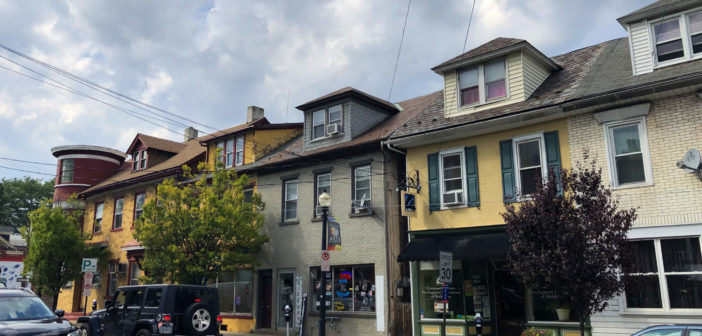Living in Bethlehem all her life, 27-year-old Amy Brensinger grew with the city as it transformed from Bethlehem Steel to the booming market it is today. She watched her parents struggle with employment, both working for Bethlehem Steel before being laid off. Her mother stayed at home, while her father became the manager of a racquetball club for 13 years until it closed.
When Brensinger was in high school, her mother returned to work as a lunch lady and her father worked as a high school hall monitor. They were poor, but at least they owned their house.
Now, Brensinger relies on her job as a server to pay rent, earning $3.50 an hour—“the most any server gets paid” compared to the minimum wage of $2.83.
“A server—it’s very unpredictable, and I would say that I don’t have job security, either,” she said. “If I were to get injured or something like that, I would just be replaced.”
With improvements in the South Side, Brensinger said the priority has shifted to recruiting wealthier residents, rather than improving affordability for low-income individuals.
The growing markets targeting middle- to upper-class residents threaten the condition of Bethlehem’s low-income population through price increases and gentrification.
“…I think…the potential concern that some folks have expressed is the impact of overall development and changing neighborhoods on prices in an area,” said Anna Smith, director of Community Action Development Corporation of Bethlehem.
New expensive restaurants and businesses in Bethlehem are not catered toward low-income residents. Luxury apartments stand in sharp contrast with the historic community.
Smith said there are fears among residents of “Who’s this for? This isn’t for me,” and “They’re making more money. Is my landlord going to want to rent to them instead of me?”
Brensinger said Five10 Flats, the newly constructed luxury apartments on Third Street, are “extremely expensive” and unaffordable for many people, not just low-income.
Even renting her house for the past four years, she had to adjust to increases in property taxes in Bethlehem that raised her rent. Brensinger was denied when she first tried to rent because she didn’t claim her tips at her job, so her wages were not recorded.
Though she graduated from Northampton Community College with a degree specializing in insurance, her education didn’t necessarily affect her income. She said a position offered at an insurance company paid $15 an hour with no commission.
“I wouldn’t be able to afford to live at all, but that’s using my degree, and I think eventually in the company, I would work my way up and be able to make money to survive,” Brensinger said.
However, she does think that a degree would be helpful for people in the long-term.
Pamela Lewis, manager of Community Partnerships at New Bethany Ministries, said not everyone wants to go to college or a trade school, but there may be consequences.
“There are going to be people that just work, and they’re not even allowed to do that because they don’t get paid enough…and therefore, they don’t deserve to have a place to live,” she said.
Smith said low-income individuals won’t have the time or energy to go back to school because they’re worried about having enough money to eat or pay rent.
Brensinger knows how it feels to not have enough money — at one point, she couldn’t afford rent, even with a roommate. She was forced to find a third roommate and borrow money from her parents.
Her father returned to employment at Bethlehem Steel, though he is nearing retirement. Both he and Brensinger’s brother work at Lehigh Valley Forge, the only portion of the steel manufacturer still in operation.
“Instead of focusing on the people who have lived here our whole lives and making it more affordable for us to continue living here, (Bethlehem) is focusing on bringing in people with more money to live here,” Brensinger said.






Comment policy
Comments posted to The Brown and White website are reviewed by a moderator before being approved. Incendiary speech or harassing language, including comments targeted at individuals, may be deemed unacceptable and not published. Spam and other soliciting will also be declined.
The Brown and White also reserves the right to not publish entirely anonymous comments.
11 Comments
While I think it’s great that Lehigh University is serving to shine a light on this issue, what’s missing from this report is the way that the college, or more accurately the students are serving to contribute to it. Consider first that in the last several years alone the number of off campus housing has increased, largely because landlords can charge students upwards of $500/room which makes many of the individuals rehabbing homes on the Southside unwilling to rent to families who can’t afford to pay rent that can easily range from $1500-$3000/month. Second, new builds such as the SouthSide Commons cater solely to students and Five10 flats which was mentioned in this article as a part of the problem was praised in an earlier article by the Brown and White: https://thebrownandwhite.com/2018/09/09/new-off-campus-housing-options-alter-south-side-landscape-the-brown-and-white/
I understand that many of Lehigh’s students are temporary residents in Southside Bethlehem but their living choices serve to have long-term impacts. The willingness of students (and/or their parents) to pay rental rates that far exceed what many current residents can or are willing to pay to live in this area serves to falsely inflate property values which in turn is leading to the slow gentrification of the area.
When was this article written?
This is the great debate when it comes to gentrification. While this article mentions the effect that Bethlehem Steel’s closing had on middle class families, it fails to mention the significant increase in crime, particularly drug and gang related, in the intervening 24 years (the main plant—”steel stacks”—closed in 1995), primarily as a result of this industrial downturn. It might not have been the former steelworkers and the community let down by Bethlehem Steel who turned to crime and drugs, but the economic conditions in the Lehigh Valley created an area of opportunity for those things to flourish. When I went to Lehigh, there were serious gang problems in South Bethlehem, particularly in the areas immediately surrounding campus. However, crime rates have fallen in Bethlehem over the past several years, likely due in part to the economic investment and resurgence in the Southside. And that’s fantastic. Who wouldn’t want to live in a safer, cleaner community with vibrant retail and restaurants? It attracts jobs and investment, like the investment in real estate that is the subject of this article. Those old row houses off campus are over 100 years old and no longer sustainable for this community revitalization. The unfortunate casualty of gentrification everywhere is the poor or lower middle class resident who is priced out of his or her community. But the flip side is that a growing economy and community will provide greater opportunities for higher paying jobs than waiting tables for $3.50 per hour. I would sooner petition my state legislator to increase the minimum wage and ban tip crediting (allowing employers, commonly restaurant owners, to pay below minimum wage in light of tips) than I would to slow the growth of a community that has suffered in crime and poverty for more than 25 years.
Hey, this is great, you’re doing exactly the right thing. Here in college, you can spend $70K+/yr of your parents’ money to develop your sense of moral injustice while displacing the poors. Unavoidable, amirite? But you can feel bad and angry, and that’s something. Then, when you graduate, you can slowly become a “realist” and start thinking more seriously about how to maximize income, focus on school district quality (yours, which is already awesome, otherwise you wouldn’t have bought there), and start planning for receipt of inheritances.
I’m very glad you’re having this opportunity to, you know, knit your brows about injustice.
Amy, you’re picking on a kid you don’t even know for writing a thoughtful article on community development and advocacy instead of some puff piece on a sorority philanthropy event or campus spirit day. You really are a piece of work.
Yep, that’s right. Now the thoughtfulness can be directed at the “what do I have to do with this picture?” question. Lucy can think of it as free tuition.
Lehigh in looking out for itself and its students has injected more money and jobs into the community. As Tiffany notes gentrification has been occuring as Lehigh expands and its students move off campus. should Lehigh do more to assist those living in South Bethlehem? I think not significantly beyond what the Lehigh community is already doing, notably at Broughal Middle School: “Always we want to take time to thank our community partners for all they do to support Broughal families throughout the course of the school year. Just Born Inc., Lehigh University, St. Luke’s, and the United Way – working with you strengthens us immeasurably and we are truly grateful for your support.”
Primary responsibility for change rests with governments and the community to initiate and effect successful solutions
Great! And Lehigh pays what exactly in property taxes?
I mean governments and the community have to have something to work with, do they not?
If rich universities are going to charge $70K and amass billion-dollar foundations, and destroy local communties in the way they so often do, I absolutely think they ought to be taxed locally at an unusually high rate, and given incentive to run more reasonably as institutions of higher ed.
https://www.washingtonpost.com/news/grade-point/wp/2016/07/08/why-should-rich-universities-get-huge-property-tax-exemptions/
That’s not “giving back to the community”; that’s “picking up one’s responsibilities as a member of the community.”
Unfortunately I am unwilling to part with a dollar to read the Washington Post article, sad but true. I would be interested in the list of Universities that have destroyed local communities. If you postulate that Lehigh has done this to South Bethlehem (SB) consider the effect of Bethlehem Steel (BS), both in the loss of jobs and the movement of those who had steel jobs away from SB when financially able to do so. Lehigh and the other Lehgh Valley (LV) institutions of higher learning provide talented people for local (LV not SB necessarily) businesses. Living in GA I would say LV is in better shape than much of PA, I’ll leave that for others to debate.
In the early days, ending in the panic of 1893,I think, Lehigh was a veritable utopia. “Packer (Asa) and Robert Sayre established the Lehigh Valley Railroad in 1846 as the Delaware, Lehigh, Schuylkill and Susquehanna Railroad Company, and changed its name in 1853. Thanks to the founders’ success, the railroad was the financial foundation of the university. For many years the railroad stock was so successful that it provided students with free tuition, as well as paid salaries for faculty, and supported an extensive building program, which included Packer Hall, now known as the University Center. I’m not sure if governments, at the time, were there to take up the slack in Lehigh’s financial problems.
So tax the daylights out of Lehigh and see what happens. It might go out of business or relocate elsewhere in the relative middle of nowhere; where if successful would have a town built around it, akin to Penn State. Stepping back from my fantasy and yours, communities are often successful when they take responsibility for their situations and work together and tirelessly for success. I’m sticking with my previous statement: “Primary responsibility for change rests with governments and the community to initiate and effect successful solutions”. Politicians often seem to not accomplish what they say they will accomplish with taxes but always find a use or misuse for the dollars. Who is to say those you want to help will be better off; or do you have an axe to grind with Lehigh?
Is it me or is Amy Charles the most miserable person on earth? You can just feel her bitterness with every word that she writes. I think the B&W should do an alumni piece on her. It can serve as a warning to current students on what not to do after graduation.
CSM: “:Is it me or is Amy Charles the most miserable person on earth?” You have visited other blog than this one I assume; there is much worse in tone and substance. She has alluded to and written of several things that give her reason to be bitter. I wish people were generally optimistic like me but I appreciate that some are different and am thankful for her thoughtful and often comprehensive comments; sometimes I agree with them.